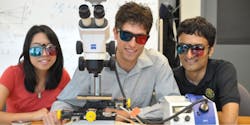Edmonton, Alberta, Canada--Engineers at the University of Alberta are using their virtual-reflected-light microscopy (VLRM) prototype to study ancient protozoa and other microfossils. The VLRM is made up of a conventional optical microscope, a light source, a multi-axis translation stage, and software that extracts shape and reflectance from the images.
The fossils were found in core samples taken from the depths of the Pacific Ocean. University of Alberta engineering professor Dileepan Joseph and two graduate students, Adam Harrison and Cindy Wong, produced the 3D imaging system. To see the full effect on a computer screen, viewers wear paper-framed 3D glasses with red and cyan lenses. Viewers also control a virtual light source, which they reposition using their web browser. Wong developed the Java applet that allows simple, intuitive interaction with the images.
Joseph and his students produced 3D images of ancient fossils that were mixed in with the sand and rock of the core samples.
Species identification
Joseph says the VRLM gives geoscientists and computer programs in development much more information than simple images. The goal is to accelerate species identification of the tiny and numerous microfossils. Such identifications are used to date the rock from which the creatures are pulled. The microfossil species digitized by the VLRM prototype were found in rock known by geologists to be 60 million years old.
Geoscientists can use that kind of strata dating information in Earth-sciences research and in the search for energy resources. The University of Alberta researchers say there are multiple industrial and academic uses for their 3D microscope technology, including metallurgic studies.

